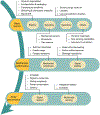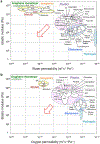Technology Roadmap for Flexible Sensors
- PMID: 36892156
- PMCID: PMC11223676
- DOI: 10.1021/acsnano.2c12606
Technology Roadmap for Flexible Sensors
Abstract
Humans rely increasingly on sensors to address grand challenges and to improve quality of life in the era of digitalization and big data. For ubiquitous sensing, flexible sensors are developed to overcome the limitations of conventional rigid counterparts. Despite rapid advancement in bench-side research over the last decade, the market adoption of flexible sensors remains limited. To ease and to expedite their deployment, here, we identify bottlenecks hindering the maturation of flexible sensors and propose promising solutions. We first analyze challenges in achieving satisfactory sensing performance for real-world applications and then summarize issues in compatible sensor-biology interfaces, followed by brief discussions on powering and connecting sensor networks. Issues en route to commercialization and for sustainable growth of the sector are also analyzed, highlighting environmental concerns and emphasizing nontechnical issues such as business, regulatory, and ethical considerations. Additionally, we look at future intelligent flexible sensors. In proposing a comprehensive roadmap, we hope to steer research efforts towards common goals and to guide coordinated development strategies from disparate communities. Through such collaborative efforts, scientific breakthroughs can be made sooner and capitalized for the betterment of humanity.
Keywords: bioelectronics; body area sensor networks; conformable sensors; flexible electronics; human-machine interfaces; mechanics engineering; soft materials; sustainable electronics; technology translation.
Figures


















References
-
- Huddleston C. What Are Intelligent Sensors, and Why Should I Care About Them? In Intelligent Sensor Design Using the Microchip Dspic, Huddleston C. Ed.; Elsevier, 2006; pp 1–19.
-
- McGee TD Principles and Methods of Temperature Measurement; John Wiley & Sons, 1988.
-
- Heng Zhang Seismoscope. https://www.atlasobscura.com/places/zhang-heng-seismoscope (accessed 2021-10-15).
-
- Johnon Warren S.. In Wikipedia. https://en.wikipedia.org/wiki/Warren_S._Johnson (accessed 2021-10-15)
-
- Global Strategy on Digital Health 2020-2025; 978-92-4-002092-4; World Health Organization, Geneva, 2021. https://www.who.int/health-topics/digital-health#tab=tab_1 (accessed 2022-09-15).

